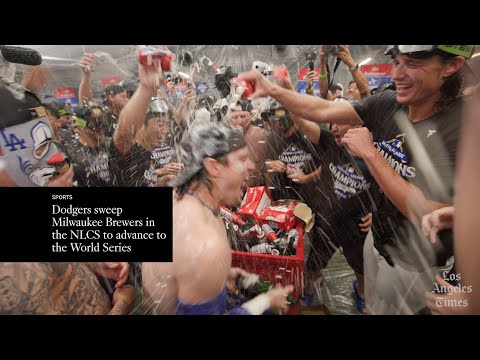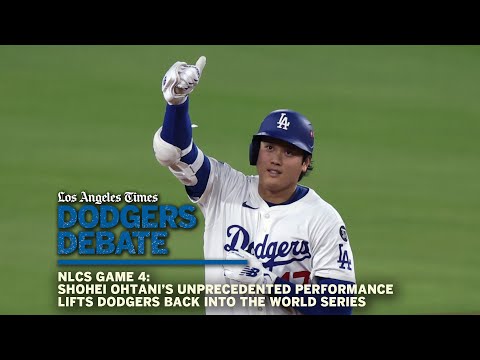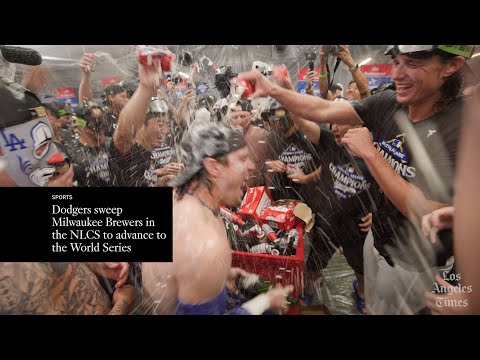Why the Dodgers’ return to the World Series was only a matter of time
From the outside, the Dodgers know the easy narrative to their season.
About how, after beginning the campaign with the highest expectations imaginable, they spent much of the year failing to live up to the hype.
How, during what was already a dismal second-half slump, they seemed to reach rock bottom when they squandered a no-hitter and three-run lead in a stunning ninth-inning loss in Baltimore last month.
How, in the six weeks since, they’ve looked like a rejuvenated and refocused club, following that nightmarish defeat with a 15-5 finish to the regular season and torrid march through October — going 9-1 en route to a National League pennant and return trip to the World Series, which will begin with Game 1 on Friday night.
In hindsight, however, the Dodgers also insist the story isn’t that simple.
The peaks and valleys of this season, they felt, were never as extreme as they appeared.
“Obviously, the season went the way it went,” veteran third baseman Max Muncy said of a 93-win campaign that, despite including another NL West title, qualified as a disappointment compared to their preseason prognostications. “It’s a long season. It’s a lot of games. We dealt with a lot.”
But, Muncy added as beer and sparkling wine were sprayed all around him in the Dodgers’ clubhouse Friday night, in celebration of the team’s fifth Fall Classic trip in the last nine seasons: “We always knew what we had in the clubhouse. We always knew what we had on the field. Now, you’re starting to see it.”
This, indeed, was always the plan. One that, even in their worst moments, they believed would happen all along.
Last fall, the Dodgers’ run to a World Series championship truly did feel surprising. Their starting rotation was ravaged. Freddie Freeman entered the playoffs with ankle and rib injuries. And there were genuine October doubts to overcome, after upset first-round eliminations the two previous years.
That team also had identifiable turning points, from a belief-instilling clubhouse meeting called by manager Dave Roberts in mid-September, to an NL Division Series comeback against the San Diego Padres that catapulted them through the remainder of the playoffs.
When they finally reached the mountaintop, led by a hobbled Freeman and heroic performances from an overachieving bullpen, it was an accomplishment of determination and perseverance; a triumph that, even internally, not everyone always saw coming.

This year, by contrast, the Dodgers viewed their path differently.
On paper, the defining point of the season appeared to be that Sept. 6 loss to the Orioles — a day that began with another clubhouse meeting from Roberts, who gathered his team amid a stunning 22-31 slump that stretched to early July; then ended in disastrous fashion, when Yoshinobu Yamamoto lost a no-hit bid with two outs in the ninth, before a withering bullpen imploded to lose the game in a walk-off meltdown.
“Losing that game, to a team that’s not even in playoff contention, you started thinking, ‘What’s wrong with us?’” infielder Miguel Rojas recalled.
But looking back last week, several other teammates said, the Dodgers never fully felt the panic that was swirling around them.
Instead, they trusted the talent of their record-setting $415-million roster to eventually rise to surface. They banked on getting healthy, then eventually turning the ship.
“We’ve been there before,” Freeman said. “We knew we were OK.”
“At some point, we were gonna start clicking,” Muncy added. “[We just needed] guys coming back and getting healthy.”
Early in the season, after all, the Dodgers had been healthy and clicking. Their 8-0 start was better than any defending champion in MLB history. Their 29-15 record through mid-May had them on a 107-win pace.
“You look at the start of the season, when we had everybody, we were playing really good,” Muncy said. “If our team was our team the whole year, maybe we would’ve lived up to those expectations.”
The Dodgers, of course, did not have their full team for much of the next three months, when they played exactly .500 baseball (49-49) from May 16 through that Sept. 6 loss in Baltimore.
On the mound, the rotation was battered by injuries to Blake Snell, Tyler Glasnow, Roki Sasaki and Tony Gonsolin. That put added strain (and innings) on a bullpen still feeling the aftereffects of the previous October.
The lineup also dealt with its own injury problems. Freeman started the year still nursing his ankle, which required surgery over the offseason. Mookie Betts was behind the eight ball from the start following a spring-training stomach virus. In the summer, Tommy Edman, Teoscar Hernández and Kiké Hernández each missed time, then returned playing less than 100%. Muncy was in and out of action during the second half, too, suffering a knee injury in July and oblique strain in August.
In retrospect, Muncy noted, it was a dynamic that the Dodgers (who have MLB’s oldest average lineup age at 30.7 years old, and were coming off a physically taxing postseason run the previous year) always figured to grapple with.
“The reality of it is — and we all know this, everyone up top knows it — our team wasn’t going to make it through the full season without breaking at some point,” he said. “So it was just, how do you weather those [low] moments?”
Problem was, they didn’t always do that well, either.
For much of July and August, the Dodgers had one of the lowest-scoring offenses in baseball, suffering from an occasional lack of focus and intensity some people in the organization later attributed to a World Series hangover.
Their faulty bullpen only made matters worse, contributing to a 5-20 record in games decided by two runs or less from early July to early September.
When Roberts called for his pregame clubhouse meeting that day in Baltimore, it was only the latest in a string of speeches he’d delivered to different groups of players on the team in prior weeks. By that point, efforts to snap out of the second-half malaise had been ongoing for a while.
“We’re doing everything in our power, having closed meetings, doing everything that we can, to try to right the ship,” Shohei Ohtani said through an interpreter on the night the Dodgers fell to second place in the division after being swept by the Angels in August. “We just have to do a better job.”
“There’s no sugarcoating this,” Freeman echoed a few weeks later, when another confounding sweep to the Pittsburgh Pirates in early September was followed by another walk-off loss to the Orioles in team’s series-opener in Baltimore. “We need to figure this out, and figure this out quick.”
That, however, is where the 2025 Dodgers differed from the previous year’s team.
Even at their lowest, they didn’t feel hopeless.
Once they got healthy again, they believed better play would follow.
“Everyone was like, ‘We’re going to hit. We’re going to pitch well out of the bullpen. It’s just going to happen,’” Freeman said. “We’ll figure it out. We’ll get there.”
The main driver of the turnaround since was the pitching. Snell and Glasnow had already returned from their injuries by September, but didn’t find a rhythm until the final weeks of the year. Yamamoto also got hot, giving up just one run in his three starts after the near no-hitter. Emmet Sheehan and Clayton Kershaw, who had been out at the start of the year recovering from surgeries, flourished to give the rotation added depth.
Ohtani (while posting MVP numbers offensively) also built his way up to a full starter’s workload, after previously being limited to short outings coming off his second career Tommy John surgery.

Sasaki, meanwhile, made a late-season return in the bullpen, giving that group an anchor it had previously been missing.
“We started winning because our starting pitching was just so good,” Freeman said, after the group produced a 2.07 ERA in September and 1.40 mark in the first three rounds of the playoffs.
“As an offense, when you see your starting pitcher just throwing zeros over and over and over again, it’s like, ‘C’mon, just get one, get two, get three.’”
That kind of consistent production indeed began to reemerge too.
There was better health and improved individual performances, especially from Ohtani, Betts and Freeman (who combined for 22 home runs and 54 RBIs during the Dodgers’ resurgence in September). There was renewed emphasis from the coaching staff on quality at-bats and team offense (helping the Dodgers average 5.6 runs per game over their final 20 contests).
There was also increased accountability the players placed on one another, challenging themselves to elevate their game the closer they got to postseason baseball.
“We always knew we were going to be a really, really good team in October,” Muncy said. “Once you get to October, it’s, ‘Alright, it’s game time.’ That’s how we’re taking it.”
That mindset has continued to manifest in the playoffs, where many of the Dodgers’ biggest moments — from the wheel play they turned in Philadelphia, to the 11-inning marathon that sent them to the NLCS, to the string of low-scoring victories they pulled out against the Milwaukee Brewers — have been born of veteran poise and a battle-tested composure.
“It’s an advantage to having such a veteran group,” Kiké Hernández said. “We’ve played in a lot of big games together.”
And now, they’ll do so again in yet another World Series appearance, playing the kind of baseball just like they expected all along.
“Showing up to spring this year, it was, ‘Hey, we need to repeat,’” Muncy recalled. “It wasn’t like we wanted to repeat. It was like, ‘Hey, we need to’ … Because that’s just how good we are.”
